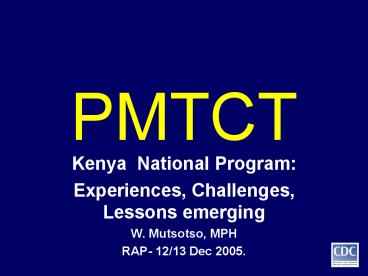PMTCT - PowerPoint PPT Presentation
1 / 19
Title: PMTCT
1
PMTCT
- Kenya National Program
- Experiences, Challenges, Lessons emerging
- W. Mutsotso, MPH
- RAP- 12/13 Dec 2005.
2
Overview
- Back ground information- Kenya National PMTCT
program - PMTCT practice in ANC and Maternity settings-
The up-scaling, progress, challenges - Towards providing a more comprehensive package of
PMTCT- A conceptual framework
3
Kenya National PMTCT Program
- In 2000 , Government recommended use of
Nevirapine for PMTCT - 2000- Pilot sites set up for PMTCT
- In 2002, developed guidelines for PMTCT programs
- 2003- Developed National PMTCT Strategic plan
(2003-2007) - 2004- National PMTCT curriculum for service
providers adopted
4
Mission Statement
- Prevent transmission of HIV from mother to child
and improve the health of mothers and their
families by providing integrated, quality,
accessible, cost effective services through
technical support, resource mobilization and
effective coordination. - Source National PMTCT Strategic Management Plan
2003-2007
5
National PMTCT Program Goals
- 80 ANC women to have access to PMTCT services
- 80 uptake HIV counseling and testing
- 80 uptake of prophylactic ARV
- 50 infant HIV infections averted by 2010
- Source National PMTCT Strategic Management Plan
2003-2007
6
PMTCT Core interventions
- Routine ANC and Maternity HIV testing
- ARV Prophylaxis Standard minimum package
- - SD Nevirapine, or
- - Combination ARV (AZT)-Limited
- settings
- Expanded package
- -HAART where feasible and women meet national
eligibility criteria. - Infant feeding counseling
7
Uptake of Testing by Testing Strategy KDH
8
PMTCT National Scale Up
9
PROPORTION OF ANC WOMEN REACHED WITH PMTCT
SERVICES
10
PROPORTION OF ANC WOMEN REACHED WITH PMTCT
SERVICES
11
National PMTCT Maternal ARV Prophylaxis coverage
Infant Nevirapine coverage 2005 56
12
PMTCT services in Maternity settings
- HIV CT has shown to be feasible in Kenyatta
National Hospital- increased opportunity for
averting infant HIV infections. - Over 90 women admitted in the maternity with
unknown HIV status accepted HIV C T and
appropriate interventions. - Source Ongech John et.al A multi pronged
approach to improve program effectiveness in KNH
2004.( Poster)
13
PMTCT services in Maternity settings-District
Hospital.
- Overall 50 women delivering in district
hospitals do not know HIV status - Presents missed opportunities.
Data from 9 facilities
14
Factors contributing to program expansion
- National coordination and supervisory framework
provided by MOH organs (NASCOP and DRH ) - A strong national PMTCT TWG (advisory)
- Use of national standardized data collection
tools and PMTCT curriculum. - The national program is a partnership between the
MoH and implementing partners - Integration of PMTCT services into existing MCH
services
15
Moving the program Forward
- What strategies will ensure that all HIV
mothers identified through the PMTCT program
receive appropriate care and follow up? - At the health facility level, where will these
mothers receive the care? - Given the rapid expansion and growth of ARV
clinics, what linkage will ensure continuity of
care for the HIV mothers and the HIV exposed
infants? - What about the care and follow up of infants?
16
PMTCT services in MCH- A conceptual Framework
17
PMTCT services in MCH-postnatal/Child clinic
18
Key lessons-Emerging issues
- Providing care and follow up at ARV clinic
associated with low uptake of services. - Providing care and follow up at MCH settings
provides better linkages for follow up of both
HIV mother and HIV exposed infant. - High cost of lab tests prohibitive to many-affect
quality of care. - Physical infrastructure in most facilities
inadequate - Inadequate Supplies-ARVs
- Infant feeding -concern
19
Thank you!!































